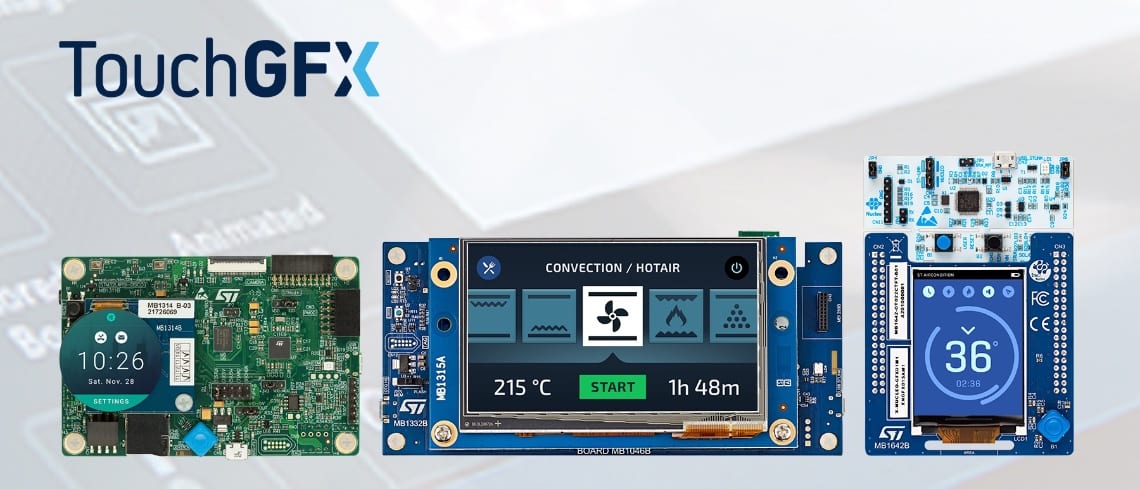Discover the features of TouchGFX 4.16
To improve the accessibility of our content, please find the audio version of this blog post.
Engineers that only look at the source code or APIs of a graphical interface framework are missing out. Mjølner Informatics, a member of the ST Partner Program, exemplifies that lesson. The company is an early TouchGFX implementer and is a highly symbolic pillar in ST’s graphical ecosystem. Indeed, its engineers work with many companies, such as PsiControl, the team behind the UI for a coffee machine. Mjølner’s contributions range from consulting services to full-scale customized software solutions. Additionally, the ST partner also offers technical training to engineering teams that will take over once the Danish company ships a UI. Mjølner is now also offering machine learning solutions on embedded systems that take advantage of STM32Cube.AI. Let us, therefore, look at the importance of the ecosystem that surrounds a graphical framework.
The Framework’s Ecosystem Is as Important as the Framework Itself
Choosing a graphical framework has many ramifications. Developers pore-over code and software tools to determine if a solution is right for them. Many try to evaluate whether a framework is efficient, flexible and suited for their application. However, this is only a piece of the equation. Indeed, a small team with little experience will seldom, if ever, write an entire UI from scratch. No matter the framework, the task itself would be too overwhelming. Interfaces are complex beasts. Indeed, there are so many things to consider when it comes to user experience and overall design that it’s easy to fall into traps that end up delaying a release to market and drastically increasing costs. Hence, the ecosystem around a framework can be as important as the framework itself. In a nutshell, ensuring a framework has support from the right partners can save a lot of time, money, and frustration.
Mjølner and ST: The Importance of Collaboration
A Solution to the Optimization Challenge
Developers often struggle with code optimizations, especially because embedded systems have memory or power consumption constraints. Hence, a code must be as efficient as possible, or projects could get too expensive. Programmers also know that the ability to optimize a system only comes after years of experience. If mastering a programming language takes years, learning the ins-and-outs of a framework is no different. However, small teams may not have the talent or resources necessary to achieve great optimizations. Hence, an ST Authorized Partner like Mjølner offers a unique value proposition by providing its years of experience with TouchGFX. For instance, it’ll always be faster to learn from their teams than by making common mistakes. As a result, TouchGFX’s ecosystem is critical because it solves the optimization challenge that many startups or smaller groups face.
A Front-Row Seat to Innovations
When optimizing a system, taking advantage of the relationship between ST and Mjølner is vitally important. For instance, the ST Authorized Partner told us that they worked on an early implementation of what later became cacheable containers, a technology that uses a bitmap cache to improve graphical performances. Similarly, Mjølner worked with some versions of partial frame buffer before we could make it public. ST publicly releases new TouchGFX features after undergoing extensive development and testing. Some of those operations take place with partners like Mjølner as we still work out issues. Hence, working with the ST Authorized Partner can help companies unfamiliar with embedded GUIs or those seeking to optimize a system.
ST and Mjølner: The Foundation of Efficient Workflows
Choosing the Right Hardware Specification
TouchGFX 4.16 and its new TouchGFX Designer features showed the importance of the PC tool when designing a UI. Developers can start their proof of concept, iterate, and then customize their interface as they get closer to production. However, engineers may struggle when figuring out the final hardware specification of their system. Choosing the right MCU or whether to add external memory is challenging, and a wrong answer may have dire consequences. An overpowered configuration will negatively affect profits, while an underpowered one will lead to a poor user experience. The solution is thus to use the services of a company like Mjølner that can help teams spec their system. Their experience from working with PsiControl, Ceribell, Nilan, and more, means they can rapidly determine what hardware is necessary.
Learning to Customize
Developers working on a UI from scratch may also feel isolated. The ST Community has a special section dedicated to TouchGFX so that anyone can ask questions to experts and engineers. However, there are situations that require a more private or tailored approach. Yet, some companies may be reluctant to outsource their UI for fear that it may limit them. As a result, Mjølner offers various levels of services. In many instances, the company will create an interface, then offer training to its customers, so their people can take over. A startup that needs to customize elements or make last-minute changes can thus confidently do so. This approach can even serve as career-building for programmers that will learn from Mjølner as they grow their knowledge of TouchGFX.
- Learn more about TouchGFX
- Check out Mjølner’s website
